Router Interactive Installation
This process assumes you have already created a bootable device using a USB. Instructions for downloading and creating a bootable device are available in Downloading an SSR ISO and Creating a Bootable USB.
Router installation can be performed using either the Interactive Installation, or the OTP process. The steps in this section describes the Interactive Installation.
The Conductor installation must be completed before installing a Session Smart Router or routers using the ISO. The same ISO is used for both installations.
For Common Criteria compliance, a dedicated, out-of-band network must be used to provide the management connection security between Conductor and Router instances. SSR software does not currently provide any evaluated security assurances for this link. This dedicated network interface must be privately routed, and must not be exposed publicly.
Prerequisites
- Ensure that the platform you are installing on is an approved Common Criteria platform:
- SSR 120
- SSR 130
- SSR 1200
- SSR 1300
- SSR 1400
- SSR 1500
- Verify that the boot priority of the USB drive is properly listed in the system BIOS.
- Local console connectivity to the device.
Installation
Connect the SSR to a Management Console
Ensure that you have an appropriate rollover cable available to connect to your computer. The SSR has a console port (CONSOLE) with an RJ-45 connector. Use the console port to connect the appliance to a management console or to a console server. The baud rate of the console port is 115200 bps.
- Connect the RJ45 rollover cable to the console port on the SSR device.
- Connect the other end of the cable to your computer.
- Insert your bootable USB with the new ISO image into the USB port of the SSR device.
- Connect the power input to the SSR device
- Power on the SSR.
Booting from the USB
Use the steps appropriate for your device to direct the device to boot from the USB for installation.
SSR100 Series Devices
- At the instruction in the terminal window:
Press ESC for boot menu, do so.
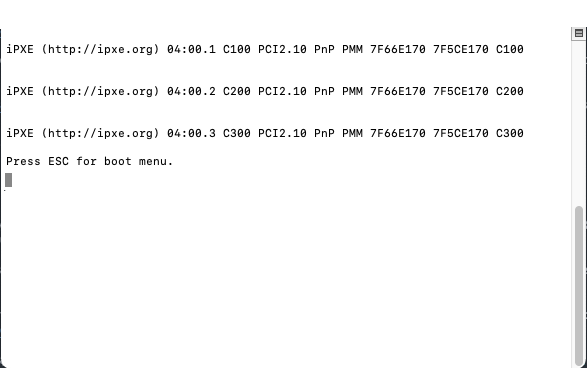
- From the boot menu, enter the boot device number corresponding to the USB, and press Enter.
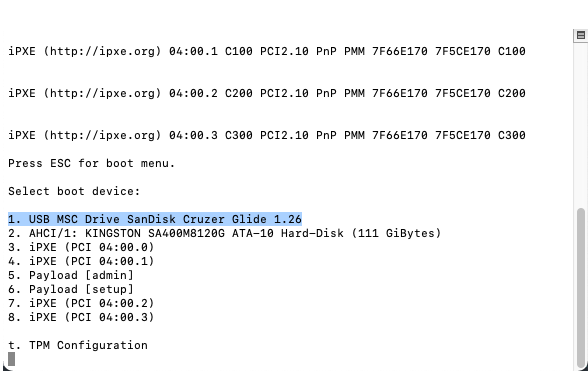
- When the USB installer boot menu is displayed, continue with the Router Installation.
SSR1000 Series Devices
- At the instruction in the terminal window:
Press <Tab> or <DEL> to enter Setup, do so.
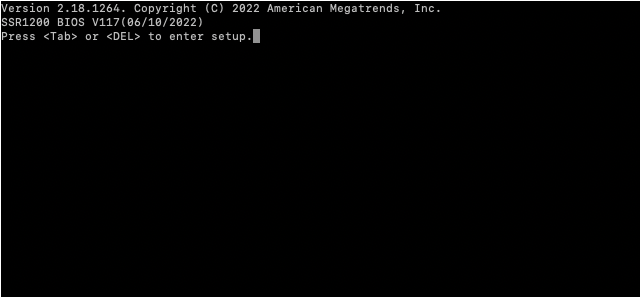
- When the Setup Utility window appears, use the left and right arrow keys to navigate to the
Save & Exittab.
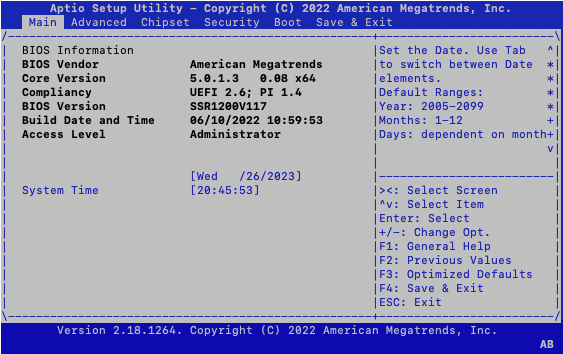
- Use the up and down arrow keys to highlight the USB device in the the Boot Override list.
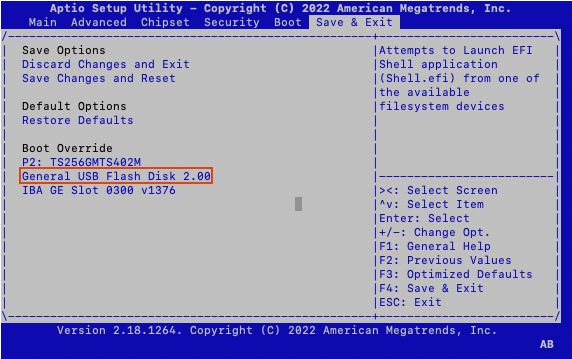
- Press Enter to confirm boot from the USB device.
- When the USB installer boot menu is displayed, continue with the Router Installation.
Router Installation
Upon boot, the following screen is displayed. The default selection is booting to the serial console (115200 baud). You must manually choose the installation process suited for your environment.
- Use the Up/Down keys to select the
Install 128T Routing Software Serial Consoleoption. This is the supported installation option for Common Criteria. It uses/dev/ttyS0115200 baud as the serial console for interacting with the installer.
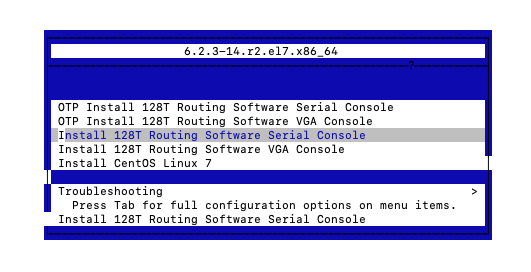
Selecting the wrong type of console (Serial or VGA) may result in garbled characters being displayed. If allowed to continue it will result in an incorrect installation. If the wrong console is selected, reboot the target system and select the correct line for the target hardware.
For serial console issues please refer to Serial Console Troubleshooting.
- Press the TAB key to edit the configuration.
To enable FIPS Enforcement for SSR software version 6.2.5-5r2, add the fips=1 kernel option to the kernel command line during system installation as shown in the steps below. This ensures that key generation is done with FIPS approved algorithms and continuous monitoring tests in place.
FIPS mode is required for Common Criteria compliance. Failure to configure FIPS mode, or the use of any other cryptographic engine nullifies compliance.
- Add
fips=1to the end of thevmlinuzparameters.
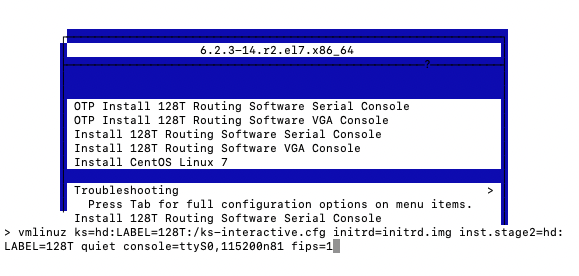
- Press Enter to start the install.
After the Linux installation is complete, the SSR software installation begins. Note that this may take several minutes to complete (up to 40 minutes). After the installation has completed, the following screen is displayed:
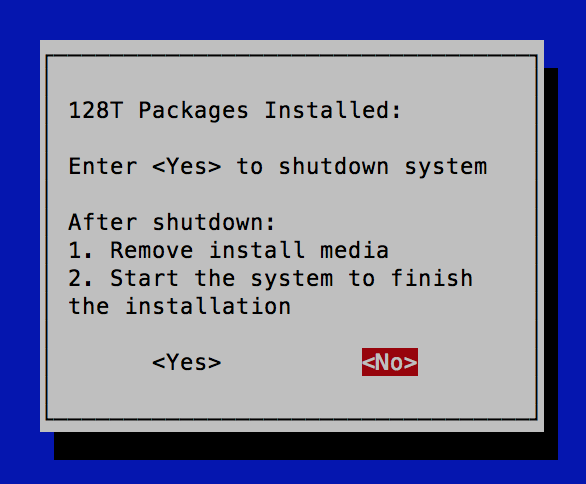
Select <Yes> to shut down the system. Remove the bootable media, then power the system up to complete the installation process.
In some cases, the screen above does appear, but becomes unresponsive after you select Yes. In this situation, you must manually power down the device (hold the power button for approximately 15 seconds), wait 10 seconds, and power it back up.
Initial Boot and Management Network Configuration
When the system boots from the Install 128T Routing Software... Interactive Installation work flow, the system asks whether to configure initial Linux Networking before the SSR Initializer is started.
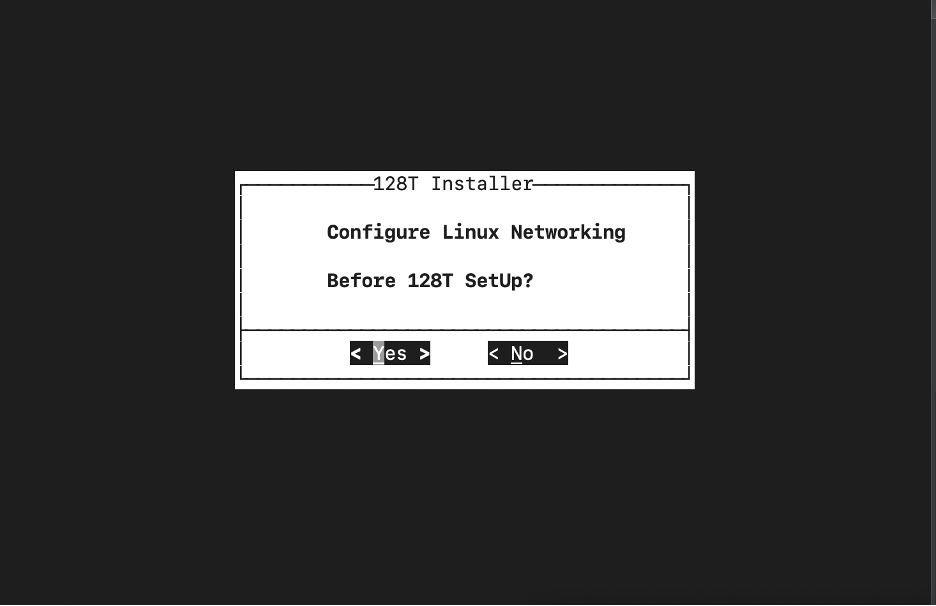
Selecting Yes launches the NMTUI application to perform an initial network interface setup.

Initialize the SSR Node
The SSR Initializer tunes your operating system, prepares the platform to run the SSR software, and creates the bootstrapping files necessary to load the software. The Initializer is launched on first boot.
- On the SSR Initializer wizard screen, use the space bar to select the Router role for the SSR node and press the Enter key to select OK.
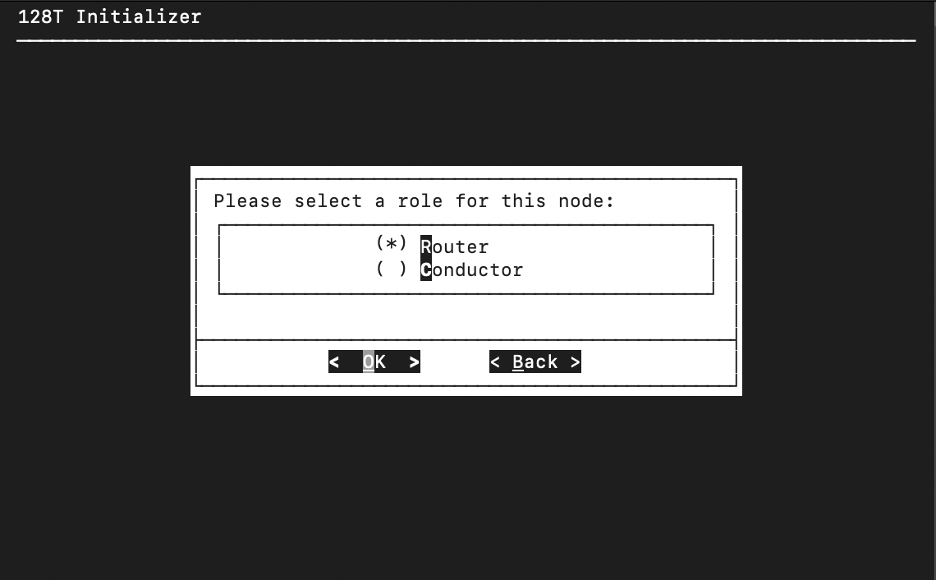
- For SSR routers, you will be prompted for the IP address(es) of the conductor. If you have a conductor, enter the administrative IP address and the node will retrieve the configuration from the conductor. If you have only one conductor (i.e., a standalone conductor), leave the field labeled 2nd Conductor Address blank. If you have no conductors, choose Skip.
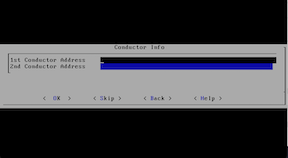
- On the Password Setup screen, create a password for the SSR Admin user. The administrator password must be at least 9 characters long, contain at least 1 uppercase letter, at least 1 lowercase letter, at least 1 number, cannot contain the username in any form, and cannot repeat characters more than 3 times. This operation is only performed on the standalone or first node in the HA peer.
Resetting a password requires entering the old password. If a password is lost or forgotten and the account is inaccessible, the account cannot be recovered. Please keep password records accessible and secure.

-
Press the Enter key to select OK. The Initializer performs a hardware compatibility check. The compatibility check may fail due to warnings or failure notices, which are displayed in the output script. If no failures are present, you can choose to continue with the installation even if multiple warnings exist. For information on why a specific test may have failed or generated a warning, contact Juniper Technical Support.
-
When prompted, select Yes to start the SSR.
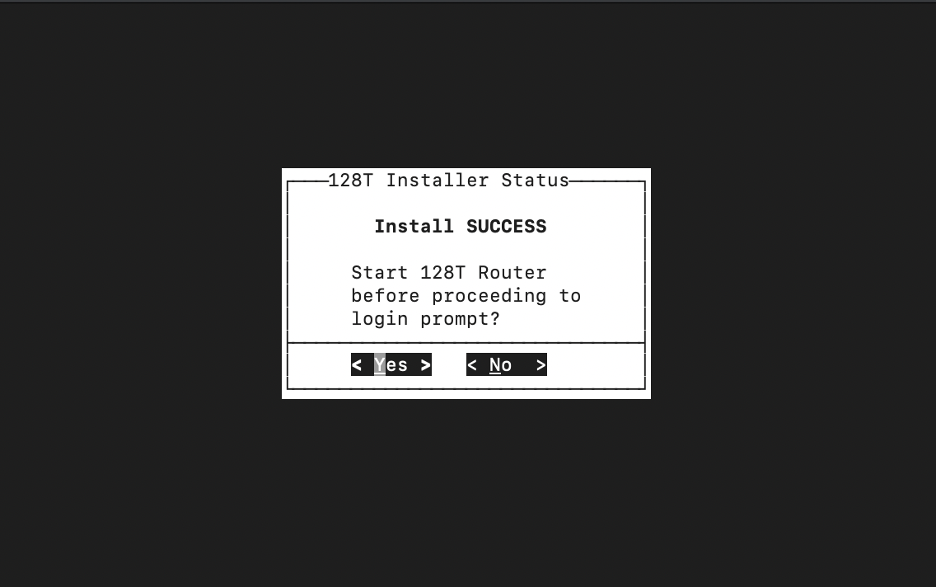
A system reboot is required.
Change the Default Passwords after Installation
The following user accounts and passwords are created during the ISO installation process:
| Username | Password |
|---|---|
| root | 128tRoutes |
| t128 | 128tRoutes |
Change these passwords immediately. Log in to the Linux shell using the default password.
Oracle Linux Server 7.9
Kernel 4.18.0-553.16.1.el8_10.x86_64 on and x86_64
localhost login: t128
Password:
Last login Wed March 26 18:17:28 on pts/0
Then use the passwd command to change the root and t128 passwords.
[t128@test-router ~]$ passwd
Changing password for user t128
Changing password for t128
(current)Linux password:
New password:
Retype new password:
passwd: all authentication tokens updated successfully.
[t128@test-router ~]$ su -
Password:
[root@test-router ~]# passwd
Changing password for user root.
New password:
Retype new password:
passwd: all authentication tokens updated successfully.
[root@test-router ~]#
The root account will not be used for day-to-day access, but the root account password should be stored securely off-box so that it can be used for admin account recovery if required.
Root Access
To permit root access to the SSR system, ensure that there is at least one user configured on each system with super user (sudo) privileges. Failure to do so may result in the loss of management connectivity to the router. SSH Root login is not permitted.
Prerequisites for installation and upgrades now include configuring a super user in /etc/sudoers that is allowed to execute Linux shell commands as root (sudo privileges). During an upgrade, if the existing version allows SSH Root login, it will be disabled. When a system is installed using the OTP ISO, a "t128" user is automatically configured with sudo privileges.
- Login using the admin credentials.
- Enter the Linux shell: Type
shellto suspend the CLI and enter the Linux shell. - Type
suand enter the default root password. - Use the following command to grant sudo privilege to the
adminuser account:/usr/sbin/visudo - Add an entry for admin as follows:
admin ALL=(ALL) ALL
- Save the file and exit from
visudo. - Type
exitto leave thesuprompt.
Software Compliance Validation
After installing the SSR Software, it is important to verify that the installation successfully completed and that the system is running in the FIPS enforcememt mode required for Common Criteria compliance. After starting the SSR router or conductor, the login screen appears on the console. Alternatively you may ssh to the SSR management IP address using the admin account.
- Login using the admin credentials.
- Use
show system versionto verify the correct software release is running:
Last login: Thu Dec 14 13:28:36 UTC 2023 on pts/0
admin@conductor.conductor# show system version
Fri 2024-03-01 16:23:37 UTC
✔ Retrieving system version 1/1 targets complete...
=========== =========== ========= ======== ====================== =====================
Router Node Version Status Build Date Package
=========== =========== ========= ======== ====================== =====================
128t-east 128t-east 6.2.5 r2 2024-06-06T23:56:25Z 128T-6.2.5-5r2.el
7 (package based)
Completed in 0.05 seconds
admin@conductor.conductor#
It should report Version 6.2.5 and Status r2.
- Type
shellto suspend the CLI and enter the Linux shell. - Execute the command
sudo systemctl status 128Tand verify the service is listed asactive (running).
[root@conductor-test admin]# sudo systemctl status 128T -l
128T.service - 128T service
Loaded: loaded (usr/lib/systemd/system/128T.service; enabled; vendor preset: disabled)
Active: active (running) since Mon 2023-7-31 18:04:29 UTC; 50min ago
Main PID: 23317 (processManager)
- Perform the following steps to verify the software integrity and protect against future tampering:
- Execute the self-test scan
sudo systemctl start 128T-rpm-verify
The self-test scan is intiated and takes approximately two minutes to complete. Upon completion, run:
systemctl status 128T-rpm-verify
The scan validates all executable files on the system against the sha256 digest hash recorded in the signed RPMs from which they were installed. This ensures that no files have been replaced or tampered with.
- Run
systemctl status 128T-rpm-verifyto confirm that the service shows:
PASS: All RPM file digests verified
- If the result displays the following:
FAIL: RPM file digest mismatch detected
The failure must be resolved before continuing to ensure compliance. The full path to each file having a self-check digest mismatch is reported as part of the status output.
- After the self-test scan test has succeed, enable the automatic self-test by executing the
enablecommand in the linux shell:
sudo systemctl enable 128T-rpm-verify
The self-test is enabled on every subsequent reboot. If the self-test fails, the 128T service will not start.
-
Perform the following steps to verify that FIPS security enforcment mode is enabled in the OS:
openssl md5 /dev/nullExpected result:digital envelope routines … Disabled for fips -
Run the following command to verify that FIPS security enforcing mode is enabled in the kernel:
cat /proc/sys/crypto/fips_enabledExpected result:1 -
Type
exitto leave the Linux shell and return to the CLI. -
Type
quitto log out from CLI.
You have now completed security validation of the installation.
CLI Access Post Install
Use the following procedure to access the CLI at any time after installation.
- Open a terminal window and SSH to the SSR's IP address.
- Use your login credentials to log in to the SSR
-
If using an account other than admin, type
pclito start the SSR CLI. -
Type
shellto suspend the CLI and enter the Linux shell.
To terminate an active session:
-
Type
exitto return from the Linux shell to the CLI. -
Type
quitto log out from CLI. -
If using an account other than admin, type
exitto end the login session.
Common Criteria certification does not require any restrictions on executing commands. See the Configuration Command Reference Guide for command information and usage.